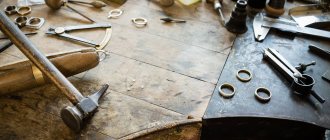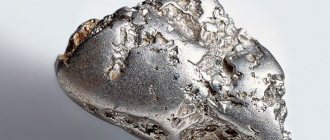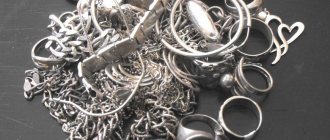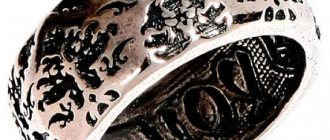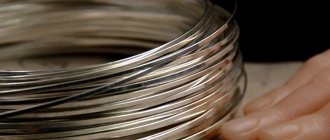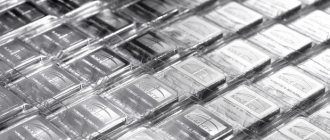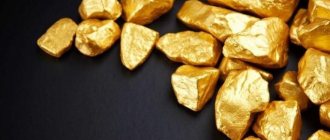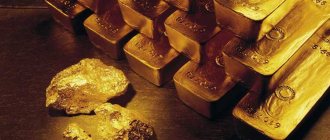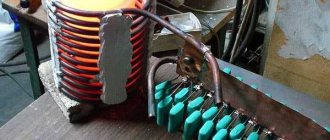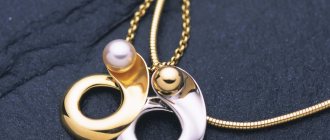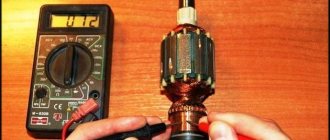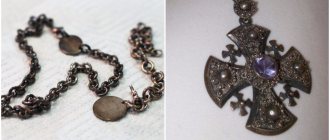Silver is a beautiful noble metal from which jewelry, coins, home decoration and dishes are made. And although silver items are counterfeited less often than gold items, sometimes it becomes necessary to verify the authenticity of the metal. How to test silver at home, read our article.
Pure silver has a silvery-white metallic hue and is highly reflective. However, if it is not cleaned for a long time, it darkens and becomes dull.
Sample and stamp
In order to check the authenticity of silver, first of all inspect the product for the presence of hallmarks and hallmarks.
The mark may look arbitrary, and sometimes be completely absent from the product. As for fineness, silver items sold on the international market must have a marked hallmark indicating the fineness of the metal. The most common numbers are 800, 830, 875, 925, 960; pure silver – 999 standard.
Do not be upset if you cannot find marks on the product - this does not mean that this is a different metal. Such a product may simply not be certified or produced in a country where the mark is not required.
The numbers on the marking indicate the percentage of silver in the alloy. For example, the 925 stamp indicates that the alloy contains 92.5% silver, and the 900 stamp indicates 90% silver content
There are other ways to test your silver. Let's take a closer look at them.
Magnet
Silver, like gold, is diamagnetic, so you can quickly check its authenticity using a magnet.
Bring a magnet to the item - if it is magnetic, it means that it is either a silver-plated item or made of another metal. If the item is not magnetic, there is a very high chance that it is real silver.
Testing with a magnet may not give the desired result if the main alloy material is copper. So, cupronickel and brass (copper alloys) will not be attracted to a magnet
Thermal conductivity
Silver has the highest thermal conductivity among metals - it heats up quickly and gives off heat just as quickly. Try temperature tests with the product.
If you have a coin or bar in your hands that needs to be checked for authenticity, use ice
Take an ice cube, place it on the product and observe carefully. If the ice melts quickly, as if it were placed on something very warm, you have silver in front of you. This test is suitable for flat items; it does not work well on small jewelry.
You can check a small piece of jewelry by simply picking it up - after a few seconds, the silver item will reach the temperature of your body. If you immerse a silver object in hot water for a moment, it will heat up to the temperature of the liquid in a matter of seconds.
Remember that silver darkens due to high temperature exposure, and in order to return it to its original appearance, you will have to clean the product
Grandma's tips
In jewelry, metal is not used in its original, pure form (the same applies to the production of cutlery). Other components are added to the alloy, which give additional strength. The classic option here is copper. To distinguish real silver from a fake, you need to talk not about Ag as such, but about the percentage of its content in the alloy.
of people living today were able to determine the purity of metal without any drugs or devices
- Argentum is very thermally conductive - it heats up quickly and cools down quickly. If you hold it in your fist, it will immediately acquire body temperature. You can put it in boiling water (if the decoration does not have stones) and then pick it up. Real metal will burn, but not for long.
- The product can be rubbed in your palms for several minutes. If the skin remains clean, the alloy is good; if dark traces remain, there are excess impurities (most often zinc).
- Silver ringing is not just a stable phrase. When gently tapped, the jewelry rattles; the argentum vibrates lightly and protractedly. The percussion instrument should be something akin to a knitting needle.
- If you place a spoon made of Ag in the sun, it will brightly reflect the rays and shine. A cheap alloy will give a dull glow, or even a barely noticeable one.
- People with a keen sense of smell (and good experience) distinguished silver by smell. They assured that pure metal smelled of freshness and lily of the valley. Now this method is hardly suitable for everyone - modern perfumery will make even iron smell like roses.
- Argentum has a high density. Even a small product made from it should be felt in your hand. And today it is so easy to distinguish silver from much lighter aluminum.
- Previously, the ring was covered with crumbs of rye bread and left there for two days. If the jewelry noticeably turned black during this time, this was a good sign - the alloy was considered to be of high quality. With today's bread this test may not pass.
- You can try to bend the spoon (plate). An object made of normal argentum will yield quite easily and will have almost no spring. But this method will not give a 100% guarantee: you can also bend a steel device. And it will be difficult to return the item to its original appearance.
All these tests were based on knowledge of the properties of Ag. Knowledgeable people could determine the authenticity of the metal by its appearance. This is probably still available to experienced jewelers.
Voice test
This test is suitable for checking coins. When tapped, silver makes a ringing sound (especially if it is tapped with another metal). If you already have a proven silver coin, its ringing can be taken as a standard.
Gently tap the silver item (you can use another coin for this): if when you tap you hear a beautiful, open ringing, then this is real silver. If the sound is dull, it means there is little or no silver in the alloy.
A silver service can become a family heirloom and be inherited from generation to generation
lapis pencil
You can buy a lapis pencil at a pharmacy. It is often used for testing precious metals at home.
Wet the product and make a mark on it with a lapis pencil: if the metal changes color, then this is a sign of a fake. Since lapis consists of silver nitrate, it does not react in any way with either silver or gold.
Lapis pencil is a somewhat outdated remedy, and you can’t buy it at every pharmacy.
Sulfuric ointment
You can check the authenticity of silver at home using sulfur ointment (sold in pharmacies).
Apply the ointment to a small area of the product and wait 2 hours. Remove it from the surface with a dry cloth and carefully inspect the treated area: if the surface has darkened, this is silver; if it has acquired a different shade or remains unchanged, the product is made of a different metal.
The test with sulfur ointment is also carried out in another way: a small area of the product is rubbed with fine-grained sandpaper and lubricated with sulfur ointment. After 15 minutes, the result is assessed. If there is a dark spot left on the treated area, then there is a high probability that this is real silver. Metals such as nickel or stainless steel will not interact with sulfur ointment, and, accordingly, no stains will remain on the product.
To remove dark spots left after sulfur ointment, you can wipe the product with ammonia or put it in a soda solution.
Modern home laboratory
In modern conditions, you can distinguish silver from a fake at home. The achievements of physics, young chemist kits, and medications are now available to people. You just need to know how to apply this or that method.
Simple and fast
A method that has been passed down from century to century is to scratch the inside of the ring with a needle. When this succeeds too easily, and a different shade is discovered under the top layer, there is a fake with spraying. But now scammers know how to make fakes that will pass such a primitive test.
There are more reliable home methods:
- Vinegar. Scratch the ring rim. Drip vinegar (away from stones). If green foam appears, then the product is most likely fake.
- Lapis. It contains Ag ions. You need to work with gloves. Rub the lapis on the jewelry and observe the reaction. A normal fusion will demonstrate its absence. The fake will turn black.
- Sulfuric ointment. Apply it to the product and leave for 2-3 hours. Then wipe the jewelry and rinse it. Argentum will become dark. A fake, depending on the metals used, will either not react or will give a yellow, pink or greenish tint.
- Iodine. You will need a white plate. Place the product on it. Drop iodine. If there is no reaction, the argentum is not real (perhaps nickel silver was purchased under its guise). A blue spot appeared - a lot of zinc. Blackness defines quality jewelry.
- Chalk (regular white will do). The ring or chain needs to be rubbed vigorously. If the jewelry turns black, it contains enough Ag.
- Magnet. Silver will not be magnetized. But this is not a very reliable method - some metals will react the same way. But this method can be effective when the links of the chain are made of different alloys. Part of the decoration will be attracted, and part of it will not.
- Ice. Place a piece of it on a piece of jewelry that has been stored at room temperature or just removed from your hand. If the ice begins to melt immediately, this is a good indicator.
Delicious recipe! Apricot juice for the winter
Some of these methods are dangerous because they can damage both the product and the utensils used. But cleaning the jewelry itself can become an additional test. Argentum can be made to shine with moonlight again by rubbing with ammonia or raw potatoes. Zinc alloy will no longer give the same shine.
In the footsteps of Mendeleev
True chemistry buffs can put their passion to work to their advantage in determining the authenticity of jewelry. Impurities in lunar metal will make it possible to identify various acids and their mixtures. In some cases, it will be possible not only to verify the presence of additives, but also to classify them.
Observing safety precautions, you can conduct the following experiments:
- With nitric acid. The product will have to be scratched. Acid should be dripped onto the damaged area. A strong green coating will indicate excess copper. Sample 925 and higher will give a beige tint. Very pure Ag will turn black.
- With potassium dichromate. It is used in photography and pyrotechnics. Clean the product, wipe with alcohol, and dry. At intervals of a few seconds, drop the solution onto it two or three times. Immediately remove excess with a napkin. A sample of 750 or more will react in red. The more argentum there is in the alloy, the redder the spot will be.
- With gold chloride. It is prepared using a mixture of hydrochloric and nitric acid (aqua regia). Clean the product. Apply the reagent to it. The result appears immediately. If the sediment is inky, a quality product is being tested. Yellow and brown colors indicate the presence of aluminum and excess copper.
- With silver nitrate. The light gray color of this reagent on the product will indicate a high sample (from 750). Cloudy white is the opposite.
You need to understand that jewelry can be damaged by using acids. Counterfeits can become completely unusable. Since zinc and tin corrode quickly, the chain may simply break.
Most tests do not provide complete confidence in the accuracy of the assessment made. You also need experience. But all of them at least partially allow us to understand what kind of product a person is dealing with.
Iodine and chalk
You can test silver with iodine.
In order not to spoil the product, carefully apply a small drop of iodine to the inner surface of the metal - a dark stain will remain on real silver. You can remove traces of iodine after testing in the following way: place the product in a bowl with grated potatoes or sprinkle with starch - under the influence of starch, traces of iodine will change their color and acquire an imperceptible bluish tint, merging with the color of silver.
Chalk not only checks, but also cleans silver. Crushed chalk is mixed with ammonia and the silver items are wiped with a soft cloth.
A similar test can be carried out using ordinary chalk. Rub the silver with a piece of chalk: a dark spot will form on the metal at the point of contact. If the blackness does not appear, you have a fake silver.
You can clean your jewelry using available products. Read how to do this in our article “How to clean silver at home.”
Vinegar
You can test silver with vinegar.
Pour the 9% table bite solution into a bowl and lower the product into the container for a few seconds. Since silver is a low-reactive metal, it will not react with vinegar. If a white coating appears on the product or other changes occur, this is a fake.
You can use a bite to clean silverware and dishes until they shine.
Metal properties
For at least six thousand years, humanity has known what silver looks like. The white (now we can add metallic to this definition) shine most likely attracted the first people to its nuggets. Initially, argentum found application in the manufacture of weapons and jewelry, but not only.
The properties of argentum noted by ancestors determine its use today:
- Silver was placed in water (or kept in containers made of this metal). The metal killed harmful microbes. Christian priests still use this method now, and there are special products for water purification and Ag-based bactericidal medicines on sale.
- “If I make silver water, I have excellent taste,” the Russian Empress Catherine II noted. Metal ions are still used today in the bottling of mineral waters. It is believed that it gives not only a healing, but also a rejuvenating effect.
- The metal was used as talismans against evil spirits, and weapons made from it were used to fight black forces. Silver amulets are also popular in the 21st century. Any jewelry made from it can be considered as such.
- Ancestors made mirrors from metal. Ag has ideal reflective properties. Nowadays, high-precision mirrors are made from it, which are used in science and technology.
- Despite its refractoriness, silver is very ductile and easy to process. Therefore, jewelry made from it is unique and varied. The finest silver threads are used in optics and electrical engineering.
This is a truly unique metal with rich properties. Previously, shiny coins were placed in milk to prevent it from turning sour longer. Nowadays, some elements for underwater vehicles and spacecraft are made from argentum, which can support enormous loads. Silver will surely take a person into the distant future.
Nitric acid
You can test silver using nitric acid - this test is considered one of the most accurate.
Wear gloves and a protective mask, select an inconspicuous area on the product, lightly scratch it to remove any protective coating, and apply a drop of nitric acid. If you have a low-quality silver alloy - cupronickel or silver-plated brass - a greenish stain will remain on the product. This is due to the fact that the product contains high levels of copper. When exposed to nitric acid, silver will turn dark, while sterling silver (925) will turn creamy.
Today you can purchase a professional silver test in jewelry stores and conduct a chemical experiment at home.
How to distinguish silver from cupronickel
The peak of popularity of cupronickel was about 50 years ago. Then almost all tableware was made from this alloy of non-ferrous metals: nickel and copper with the addition of manganese and iron. This composition provided high wear resistance and strength, while not being inferior in ductility to silver.
It is almost impossible to determine by eye whether you are looking at cupronickel or silver. Use the sewing needle method to identify silver. If the needle leaves a dark mark, this means cupronickel.
You can also try nitric acid. Silver will darken, cupronickel will turn green.
Physical impact
You can check the authenticity of silver using physical impact.
Rub the product to be tested in your hands for 1-2 minutes. If you have high-quality silver in front of you, then your hands will remain clean after rubbing; if the product contains zinc impurities, barely noticeable dark spots will remain on your fingers.
Try testing your silver with a needle. If you suspect that you have a silver-plated product, lightly scratch an inconspicuous (internal) area with a needle: a thin layer of silver will easily be removed from a fake, but nothing will happen to the genuine metal.
The expert will give accurate information about the authenticity of silver and determine the content of impurities of other metals
All the methods described above will help determine the authenticity of a silver product with a certain degree of probability. To get a 100% guarantee, have your item examined by professionals: they know exactly how to test silver.
White paper
Take a blank sheet of paper. Run a corner over it. Silver will leave a mark, like a simple pencil, but a fake will not.
Metal detector with discrimination function
A metal detector - a device with a metal discriminator - will help you determine whether it is silver or not. This is a special function for determining the composition of metal objects. Swipe the sensor a short distance and then read the text on the monitor.
Gold chloride solution – Au2Cl6
This is a very expensive chemical. It is used by jewelers and customs officers. Checking the authenticity of items without hallmarks (for example, coins) will reveal not only Ag, but also other materials.
| Interaction time, sec. | Color | Predominant metal |
| 1 | dark green | silver |
| 2 | yellow | Al |
| 30 | black | tin |
| 40 | does not change | platinum, gold |
| 1-2 | inky black | brass, copper |
| 300 | chestnut | Au-Ag alloy |
A low-grade alloy with copper will turn black, while a high-grade alloy will give a dirty gray tint with a greenish tint.
